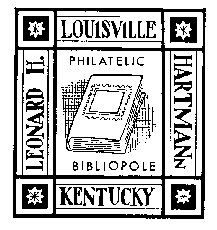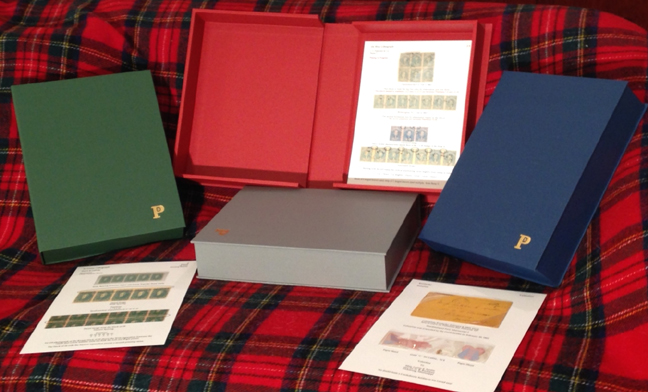 BOOKS on PHILATELY
BOOKS on PHILATELY BOOKS on PHILATELY
BOOKS on PHILATELY
Though our pages are heavy there is enough flexibility so they can be hand fed through an office size Xerox or LaserJet printer and receive a better image than regular paper, they are also ideal for hand inking and typing. They are not punched for a binder so you have the full surface for mounting and an attractive format for exhibiting. We have found that most newer LaserJet printers will take the paper from the normal tray but we still suggest the hand feed, you run normal paper from the tray and once you get the page right hand feed a sheet of our paper.
To protect each pages we offer special side entry DuPont Melinex ®516 Page Protectors made especially for us to accommodate our heavy paper. We prefer the side entry over the top entry as the page is protected from things falling into it and it is easier to insert the page into the long side of the Page Protector. Mylar D is no longer made however the new DuPont Melinex ®516 is equal for archival preservation.
To finish off the package we offer our own Clam Shell Boxes to hold the pages in the Protectors. These boxes are sturdy and attractively made, a heavy spine and a heavy cloth covering and paper lining. A similar design of folding boxes have been used by archivists to house rare books and documents for many years. They will open flat for convenient sorting and viewing of the pages and close for storage in a bookcase.
Our paper is quite unusual in that we have a neutral pH with a low alkaline reserve. This is why pH analysis are virtually the same before and after aging. In making paper that is only pH neutral is easier, and more economical, to add additional calcium carbonate to neutralize the acid and create a greater alkalinity reserve than to wash out the salts from the pulp in the first place.
Oversize, 11 x 17 inch, Made especially for us, 3 mil, one long side open, sized for our 11 x 17
Unfortunately they are no longer available and we know of no similar product and offer the below
We are now stocking Hawid mounting strips with a CLEAR backing that we find acceptable for stamps and most covers. We have many reservations on the use with Stampless Folded letter and other Thick items, sorry about this.
For a stamp or cover i suggest cutting a bit larger than the stamp or cover, if a large item you may wish to use two strips, one on the bottom and one on the top for added stability, you may want to overlap a bit. They are available in numerous heights but for now we are stocking the below two sizes that work for most applications, they can be easily cut to fit.
The strips are a bit over 8.5 inches in length, can be easily cut, adhesive is water activated and in a frame are not easily visible.


A home or office at say 65 to 75°F and 50 to 60% Relative Humidity is both convenient and a responsible environment. To place stamps, books, art objects, furniture, etc. in a hot attic, a damp basement, an unheated entrance hall, a damp safe, any unattended area, etc. is not prudent.
The primary purpose of any collection is your enjoyment. From time to time thumb through the pages, you will enjoy seeing old friends, it will also "air things out" and give you the opportunity to see if storage problems exist.
Our album pages and the DuPont Melinex ®516 pockets are inert. Albums, slip cases and page boxes are not inert as they are not in direct contact with the material. These containers do much to assure the preservation as they minimize the contact with light, dirt and air pollution in addition to keeping everything together.
Our paper is made and the pages finished in the USA, 100% cotton, peroxide bleached, well washed, no optical brighteners, neutral pH, ie 7, buffered with only a small amount of calcium carbonate, prepared for true archival preservation. Though these are thick pages the there is enough flexibility so they can be hand fed through an office size Xerox or LaserJet printer and receive a better image than regular paper. They are also ideal for hand inking and will hold hinges and mounts well. This paper should not be confused with ground wood pulp which has been neutralized to a 7 pH, such paper still contains all the destructive ingredients, they have just been restrained.
The pages are 8.5 x 11 inches and are not punched for a binder. Any good office punch would make the holes but we think the un-punched pages are preferable. First you have the entire surface for mounting, with holes you loose about 1.5 inches on the left. Second we think preservation in a DuPont Melinex ®516 Page Protector and a Page Box is preferable to either a ring or post binder. The binder necessitates page flexing which could be detrimental. The hinged page as is used with the Frank Godden and other better albums was developed to minimize the flexing problem but adding a Page Protector negates much of the effect of the hinge.
To protect each pages we offer special side entry Melinex Page Protectors made for us. We prefer the side entry over the top entry as the page is protected from things falling into it and it is easier to insert the page into the Protector.
To finish off the package we offer our own Clam Shell Boxes to hold the pages in the Protectors. These boxes are sturdy and attractively made, a heavy spine and a heavy cloth covering and lining. A similar design of folding boxes have been used by archivists to house rare books and documents for many years. They will open flat for convenient sorting and viewing of the pages and close for storage in a bookcase.
This was excellent advise and well founded in fact. Times have changed but then they have not and the advice is still good. Paper that is either acid or alkaline or loaded with salts will change with time but today we have paper that will not. Prior to circa 1820 all paper was both rag and not chlorine bleached which gives one excellent long time stability. New technology lowered the costs of paper, first by introducing chlorine bleaches and then with wood pulp. Both developments shortened it's life, by the 1890's most paper was extremely poor. It has only been since the 1980's that there has been a general interest in producing paper with a reasonable expected life. Reasonable expected life, one would expect a normal reference book to last 100 years, certainly not archival but in one's life it would not fade and could be passed along to the next generation. For fine philatelic material we have higher expectations. For the newspaper 6 wk s is enough.
With our PB paper we do not expect that there will be any noticeable change in the next several hundred years if properly handled. Still the advice to buy a quantity is good as the exact paper stock may not always be available. In May, 1992 we learned that our paper mill had been bought out and the new owners would not make our paper except in lots of 20,000 lbs, another mill offered to make 10,000 lbs batches but as they had never made such paper there was much risk and we could not justify the quantity.
Most LaserJets have a back door, which when opened will subject the paper to less flexing and jamming than the regular discharge point. This is the recommended path and is probably the best but you have nothing to lose in trying the regular.
Hand feeding is available on many LaserJet printers and Xeroxes, this will probably subject the paper to less flexing. You should try this as opposed to the normal paper tray to see what is best for your system.
We find the hand feeding convenient, we keep running copies on regular paper out of the paper tray until we get exactly what we want and then stick in a sheet of PB paper for the final print. On some printers we have found that the regular paper tray works best so you best try them both.
DuPont Melinex ®516 is now considered best archival plastic and we think it is ideal for Page Protectors but not for Cover Corners. Melinex will not stick with any inert adhesive thus to attach the Corner to a page you must either use a Non Hardening adhesive or you must cut the album page so a Welded Prong can be inserted through the page. We don't like the Non Hardening adhesive and the Prong design is only applicable to Museum Cases where the page is never moved. The edges of our Page Protectors are welded, not glued.
There is another problem with Melinex and the old Mylar for Cover Corners; these plastics are quite hard, the sharp edge that contacts the cover or stamp can easily wear a thin spot in the paper, fray a cover or stamp edge, etc.
What else is there! Several friends like the Large Old Cover Hinges, wonderful but a decent stamp hinge is hard to find these days and the Large Old Cover Hinges haven't been made for many years. There are various small plastic and or paper corners and some plastic strips from Germany but we find them all lacking. The corners are too small, unattractive and the plastic strips require considerable manual dexterity to use plus they are often too light to hold a cover.
Please Remember, you must keep your collection in a good environment; the finest paper and Melinex can not protect against the ravages of high heat and humidity, polluted air, and problems with the original stamp or cover such as bad paper and ink, etc.
The new Hp series of printers seems to be quite tolerant for our paper and you can often leave it at the normal paper settings however it might be advisable on the paper selection to increase the weight of the paper, this will increase the fuser temperaturee to make sure the toner is well set, years back in the printer set up they had a setting for ARCHIVAL paper which upped the temperature a bit and it worked fine for us. If you run a white cloth over a printed page and there is a bit of color on the cloth you need to up the paper wate setting.
If you care to e-mail we will help as best we can.
Hp LaserJet Printers
All orders to a US mailing address:
The above is a guide on postage, the larger the order the lowere the total cost
All orders to a Non US Mailing Address
Philatelic Bibliopole
PO Box 36006, Louisville, Ky 40233, USA